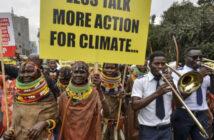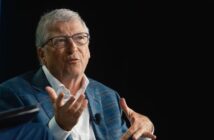A new approach to tackling global development issues will be adopted by United Nations on September 21 2015. It is called the Sustainable Development Goals, (SDGs) a successor programme to Millennium Development Goals (MDGs), Hajiya Amina Al-Zubair, Special Adviser to U.N. Secretary General stated during the week.
It would be recalled that Ban Ki-Moon, United Nations Secretary General was in Nigeria during the week on a two day working visit. Although the MDGs were realistic and easy to communicate, with clear measurement and monitoring mechanism, investigations reveal that the eight goals which were established at inception have not been realized particularly the first and most important goal which pertains to eradicating extreme poverty and hunger.
In September 2000, leaders of the 189 countries gathered at the United Nations headquarters and signed the historic millennium declaration, in which they committed to achieving a set of eight measurable goals that range from having extreme poverty and hunger to promoting gender equality and reducing child mortality, by the target date of 2015. There are eight major goals for the establishment of MDGs. The first goal is to eradicate extreme poverty and hunger. Second is to achieve universal primary education, goal 3 is to promote gender equality and empower women, the 4 aim is to reduce child mortality; it was also established to improve maternal health; to combat HIV/AIDs, malaria, and other diseases; to ensure environmental sustainability; and then to develop global partnership for development.
The MDGs were revolutionary in providing a common language to reach global agreement. The MDGs expires this year (2015) and the discussion of a post-2015 agenda continues. Also, the focus is now on building a Sustainable Development Goal (SDG). The thought process of establishing an SDG began in June 2012 at the United Nations Conference in Rio de Janeiro, and the purpose for the SDG is to carry on the momentum generated by the MDGs and fit into a global development framework beyond 2015.
In the interest of creating a new, people-centered, development agenda, a global constitution was conducted online and offline. Civil society organizations, citizens, scientists, academics, and the private sector from around the world were all actively engaged in the process. Activities included the MyWorld survey led by the United Nations Development Group, specialized panels were also held and provided ground to facilitate intergovernmental discussions. The UN Secretary General presented a synthesis of the results of these consultation processes.
In July 2014, the UN General Assembly Open Working Group (OWG) proposed a document containing seventeen goals to be put forward for the General Assembly’s approval in September 2015. This document sets the ground for future negations of the new SDGs and the global development agenda spanning from 2015-2030. Goal 1 is to end poverty in all its forms everywhere; the second goal is to end hunger, achieve food security and improved nutrition, and promote sustainable agriculture; goal 3 is to ensure healthy lives and promote well-being for all at all ages; the fourth goal is established in order to ensure inclusive and equitable quality education and promote life long- learning opportunities for all; goal 5 is to achieve gender equality and empower all women and girls; while 6 is to ensure availability and sustainable management of water and sanitation for all; and the seventh goal is to ensure access to affordable, reliable, sustainable, and modern energy for all.
The eight goals for the establishment of SDG is to promote sustained, inclusive and sustainable economic growth, full and productive employment, and decent work for all; goal 9 is developed to build resilient infrastructure, promote inclusive and sustainable industrialization, and foster innovation; goal 10 is to reduce inequality within and among countries and the eleventh goal is to make cities and human settlements inclusive, safe, resilient and sustainable; goal 12 is to ensure sustainable consumption and production patterns; goal 13 is to take urgent action to combat climate change and its impacts. Goal 14 is to conserve and sustainably use the oceans, seas and marine resources for sustainable development; goal 15 is to protect, restore and promote sustainable use of terrestrial ecosystems, sustainably manage forests, combat desertification, halt and reserve land degradation, and halt biodiversity loss. Goal 16 and 17 are certainly not left out as their aims are to promote peaceful and inclusive societies for sustainable development, provide access to justice for all, and build effective, accountable and inclusive institutions at all levels; and as well to strengthen the means of implementation and revitalize the global partnership for sustainable development.
The Millenium Development Goals (MDGs) mark a historic method of global mobilization to achieve a set of important social priorities worldwide. They express widespread public concern about poverty, hunger, disease, unmet schooling, gender inequality, and environmental degradation. By packaging these priorities into an easily understandable set of eight goals, and by establishing measurable set of eight goals, and by establishing measurable and time bound objectives, the MDGs help to promote global awareness, political accountability, improved metrics, social feedback, and public pressures. As described by Bill Gates, the MDGs have become a type of global report card for the fight against poverty for the 15years from 2000 to 2015.
According to reports, some countries have made substantial progress towards achievement of the MDGs, although the progress is highly variable across goals, countries, and regions. Some countries will achieve all or most of the MDGs, whereas others will achieve very few. By 2015, most countries may have made meaningful progress towards most of the goals. Moreover, for more than a decade, the MDGs have remained a focus of global policy debates and national policy planning. They have become incorporated into the work of non-governmental organizations and civil society more generally.
Investigations reveal that shortfall in achievement of the MDGs is indeed serious, regrettable, and deeply painful for people with low income. The shortfall represents a set of operational failures that implicate many stakeholders, in both poor and rich countries. Promises for example, have not been kept. Nonetheless, there is widespread feeling among policy makers and civil society that progress against poverty, hunger, and disease is notable, that the MDGs have played an important part in securing that progress, and that globally agreed goals to fight poverty should continue beyond 2015. In a world already undergoing dangerous climate change and other serious environmental ills, there is also widespread understanding that worldwide environmental objectives need a higher profile alongside the poverty-reduction objectives.
For these reasons, the world’s governments seemed poised to adopt a new round of global goals to follow the 15-year MDG period. UN secretary General Ban Ki-Moon’s high-level global sustainability panel, appointed in the lead-up to the Riot 20 summit in June 2012, has issued a report recommending that the world adopt a set of Sustainable Development Goals (SDGs). The SDGs are an important idea, and could help finally to move the world to a sustainable trajectory. The detailed content of the SDGs, if indeed they do emerge in upcoming diplomatic processes, is very much up for discussion and debate. The content should focus on global priorities that need active worldwide public participation, political focus, and quantitative measurement and lessons from the MDGs, especially the reasons for their successes, and corrections of some of their most important shortcomings.
The idea of the SDGs has quickly gained ground because of the growing urgency of sustainable development for the entire world. Although specific definitions vary, sustainable development embraces the so-called triple bottom line approach to human well-being. Almost all the world’s societies acknowledge that they aim for a combination of economic development, environmental sustainability, and social inclusion, but the specific objectives differ globally, between and within societies. A shared focus on economic, environmental, and social goals is a hall mark of sustainable development and represents a broad consensus on which the world can build.
The SDG was borne out of the fact that the MDGs were supposed to have achieved by 2015 and was not fully achieved, particularly MDG1 which focuses on eliminating poverty and MDG3 which has to do with the goal of gender equality between men and women, and boys and girls, hence the SDG serves as a continuing process of the MDGs. Policy analysts believe that economic dimension should build on the MDGs, which have helped to advance the worlds agenda in the fight against poverty, hunger, and disease. Between 2015 and 2030, the world should aim not merely to achieve the MDGs where they have not been met, but to carry on with the task initiated at the very start of the UN itself (and represented in the Universal Declaration of Human Rights), to secure the basic material needs and human rights of everybody on the planet earth. To declare that by 2030, all extreme deprivation, hunger, extreme income poverty, and avoidable disease and deaths can be eliminated is both realistic and profound. All individuals should be able to access safe water and sanitation, electricity, connection to information and communication technology, primary health care, and to be protected from natural hazards. Many places will remain poor, but no place should be destitute, unable to meet these basic needs, although a key challenge is to adopt a meaningful standard of basic needs world wide.
One of the notable facts about poverty is that well over half of the 1billion people with a low income are living in middle-income countries, which means that they are living in societies with the financial and technological means to address their remaining poverty (as Brazil and China have effectively and notably done in recent years). Although hundreds of millions of impoverished people still live in the least developed countries, they are a dwindling proportion of the world’s poorest people, such that small financial and technological transfers from high-income and middle-income countries can alleviate their plight.
From 2015 to 2030, all nations will adopt economic strategies that increasingly build on sustainable best practice technologies, appropriate market incentives, and individual responsibility. The world will move together towards low-carbon energy systems, sustainable food systems, sustainable urban areas (including resilience in the face of growing hazards), and stabilization of the worlds population through the voluntary fertility choices of families supported by health service and education. Countries will adopt a pace of change during these 15years individually and with global cooperation, that will enable humanity to avoid the most dangerous planetary thresholds. The world community will help low-income countries to bear the additional costs that they might entail in adoption of sustainable systems for energy, agriculture, and other sectors.



